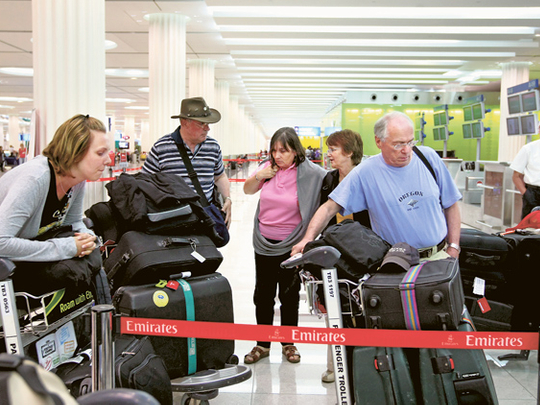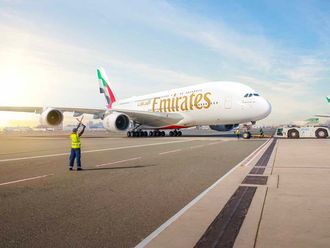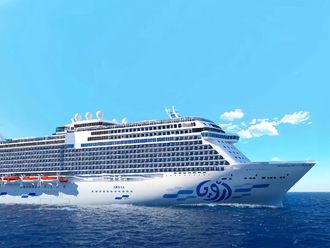
Dubai: Pitched against big global airlines, the Middle Eastern carriers are storming ahead of the competition at an unmatched pace.
And giving impetus to their progress — especially by the big three Gulf carriers Emirates, Etihad Airways and Qatar Airways — is a strong growth strategy, huge investments in aviation infrastructure projects, massive aircraft orders, and most important, their ability to quickly emerge from industry setbacks.
In an exclusive interview with Gulf News, aviation expert Toby Stokes, Ernst & Young (E&Y) Middle East Airline Sector Leader, shares what the region's aviation scenario will look like a few years from now.
GULF NEWS: What kind of overall growth do you predict for the aviation sector in the Middle East?
Toby Stokes: Despite the issues which have affected the Middle East aviation sector in the first quarter of 2011, the industry is predicting exceptionally strong growth for the region, with IATA (International Air Transport Association) forecasting nearly 15 per cent growth in total traffic in 2011 versus 2010.
Do you think the massive investment planned into airport development projects across the region is justified?
The investments in the region's airport and supporting aviation infrastructure are significant. However, the forecast for growth in air traffic for the Middle East over the next few years is also large, and the current facilities would not have been able to cope with this major increase.
How do you see airlines in this region raising finance for future aircraft orders? Will wee see more of them issuing bonds? Or would IPO be the way going forward for the big 3?
The airlines operating in the Middle East each have their own financing strategies in place to fund the future aircraft orders, whether that is from existing shareholders, private financing or public funds.
According to press reports last month, Emirates announced a dollar-denominated bond issue, and Qatar Airways has stated its plans for an IPO after three years of profitability.
What are your thoughts on the consolidation in the airlines sector in the Middle East?
Globally, carriers are going that way in order to rake up revenues money in a cash-tight environment. And we are also seeing more and more consolidation in the airline industry worldwide, with the merger of British Airways and Iberia and Continental and United being the two latest big consolidation plays.
However, to date the consolidation has been focused on the mature markets of North America and Europe, where airlines face different challenges to those operating in the Middle East
Whilst I would never say consolidation in the Middle East is out of the question in the future, for now the principal Middle East players each have their own expansion strategies, principally focused on organic growth.
Will we see this region's airlines getting into alliances and agreements going forward?
Alliances and other forms of business agreements are becoming more commonplace in the industry globally, both to share costs and offer a wider network and benefits to passengers, as well as to comply with the various operating and regulatory regimes of individual countries.
For the Middle East, we are seeing more activity with the big global alliances, with Royal Jordanian being a member of OneWorld and Saudi Arabian Airlines recently joining Skyteam. Additionally, Etihad already has established a partnership with Virgin Blue and Virgin Australia, and Qatar Airways recently announced it was planning to acquire a shareholding in Cargolux, the European based cargo only airline. So I believe further cooperation in various forms is likely in the future.
Do you see overcapacity posing hurdles to the regional carriers' growth — especially of the big three — Emirates, Etihad and Qatar Airways, considering they have massive aircraft orders?
The aircraft orders from the big three Middle East airlines are significant, and managing the increase in capacity with future demand will be a key factor in the region's continuing success and growth.
Growth in air travel, measured in revenue passenger-kilometres (RPK), has historically outpaced economic growth, represented by GDP (gross domestic product), by approximately 1.5 to 2.0 per cent.
Additionally, although individual regions may exhibit signs of slowing due to maturing markets, other regions, such as the Middle East and Asia continue to grow vigorously. It is also important to remember that a portion of the future deliveries will be to replace existing aircraft which are due to be retired from the fleets.
How do you see this region's airlines (the big 3) revising their fuel hedging strategy in the future given the volatility in oil prices?
At an industry level fuel, hedging is commonplace at airlines, but each airline has its own unique strategy, approach and policies with regards to fuel hedging. This is largely driven by the airline's appetite for risk versus certainty.
According to IATA estimates, 50 per cent of the industry's fuel requirement is hedged at 2010 price levels and the industry 2011 fuel bill will rise by $10 billion to $176 billion.
Fuel is now estimated to comprise 30 per cent of airline costs — more than double the 13 per cent of 2001.
Do you see carriers in the region raising airfares this year owing to unpredictable oil prices?
The use of a fuel surcharge in periods of high oil prices is common across the industry, both in the Middle East and globally, and during 2011 the majority of global carriers, including the Middle Eastern carriers have increased the fuel surcharge as a means to combat the soaring oil price.
However, recently as we have seen a dip in the oil price, we have observed airlines reducing the surcharge accordingly, for example in May 2011 Emirates announced it was removing the fuel surcharge on all tickets.
What kind of growth do you foresee for budget carriers in the region? Will we see more budget carriers coming into the market? Is there room for more?
The Middle Eastern low-cost carrier (LCC) segment is relatively new and still has significant growth opportunities. With the Arab world having a population larger than the US, and with other forms of public transport relatively scarce, the principle method of travel will continue to be by air, and a portion of that population would be attracted to low cost air travel.
I think that as the low-cost market develops further there will inevitably be new entrants to the market. If you look at the European short-haul market, which is relatively mature and advanced compared to the Middle East market, there are over 60 LCCs currently operating, so there is a great opportunity for growth in this region.
What are some of the key issues facing the Middle East aviation industry today?
Recent developments in the region had initially affected the demand growth for this sector. Middle East airlines saw demand growth fall from 12 per cent in January 2011 to 8.4 per cent in February and 5.6 per cent in March (versus 2010), but bounced back in April with 11 per cent growth year on year.
In the short term, the natural disasters in Asia and Australasia at the start of this year, and the current situation in some countries across the Middle East have had a significant effect on all airlines across the world, including Middle East carriers.
Not only has intra-Middle East traffic been affected but oil prices have risen above $100 per barrel for a sustained period of time.
For every $1 the oil price increases above IATA's 2011 revised forecast average of $96 per barrel, the global airline industry adds approximately $1.5 billion of cost.
The trend in oil prices for the rest of 2011 will have a significant impact on the global and Middle East airline performance.
In the long term, however, the sluggish economic recovery in the mature markets of North America and Europe has had a large impact on airlines operating in these regions, and we are seeing a widening of conditions by geography and a two-speed global airline market developing — slower in the mature markets and faster in the developing markets, including Asia Pacific and the Middle East.
What are your views on Dubai's second airport — the DWC-Al Maktoum International?
The new DWC-Al Maktoum airport development is more than just an airport. DWC is envisioned as a luxurious residential, commercial and logistics complex as well as the new international airport.
The size and scale of the project, an estimated $82 billion cost, is another example of the vision Dubai shows.













